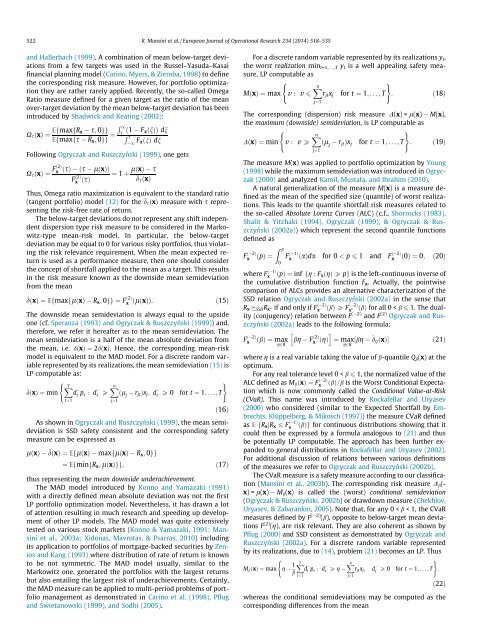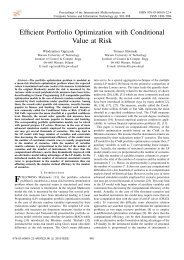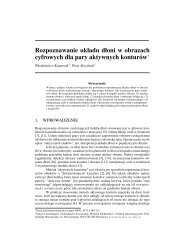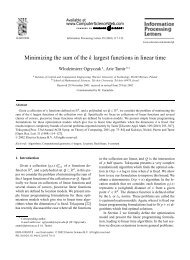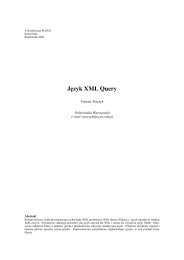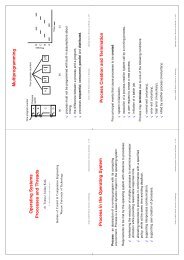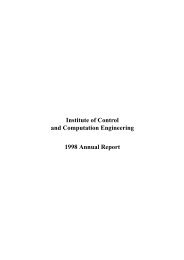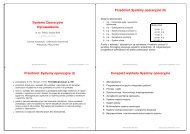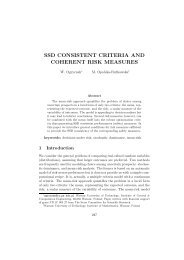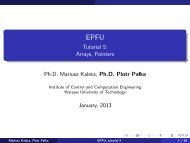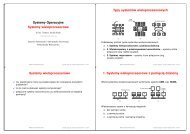Twenty Years of Linear Programming Based Portfolio Optimization
Twenty Years of Linear Programming Based Portfolio Optimization
Twenty Years of Linear Programming Based Portfolio Optimization
You also want an ePaper? Increase the reach of your titles
YUMPU automatically turns print PDFs into web optimized ePapers that Google loves.
522 R. Mansini et al. / European Journal <strong>of</strong> Operational Research 234 (2014) 518–535<br />
and Hallerbach (1999). A combination <strong>of</strong> mean below-target deviations<br />
from a few targets was used in the Russel–Yasuda–Kasai<br />
financial planning model (Carino, Myers, & Ziemba, 1998) to define<br />
the corresponding risk measure. However, for portfolio optimization<br />
they are rather rarely applied. Recently, the so-called Omega<br />
Ratio measure defined for a given target as the ratio <strong>of</strong> the mean<br />
over-target deviation by the mean below-target deviation has been<br />
introduced by Shadwick and Keating (2002):<br />
X s ðxÞ ¼ EfmaxfR R 1<br />
x s; 0gg<br />
Efmaxfs R x ; 0gg ¼ s ð1 F xðnÞÞ dn<br />
R s F 1 xðnÞ dn<br />
Following Ogryczak and Ruszczyński (1999), one gets<br />
X s ðxÞ ¼ Fð2Þ x<br />
ðsÞ ðs lðxÞÞ<br />
F ð2Þ<br />
x ðsÞ ¼ 1 þ lðxÞ s<br />
d s ðxÞ<br />
Thus, Omega ratio maximization is equivalent to the standard ratio<br />
(tangent portfolio) model (12) for the d s ðxÞ measure with s representing<br />
the risk-free rate <strong>of</strong> return.<br />
The below-target deviations do not represent any shift independent<br />
dispersion type risk measure to be considered in the Markowitz-type<br />
mean-risk model. In particular, the below-target<br />
deviation may be equal to 0 for various risky portfolios, thus violating<br />
the risk relevance requirement. When the mean expected return<br />
is used as a performance measure, then one should consider<br />
the concept <strong>of</strong> shortfall applied to the mean as a target. This results<br />
in the risk measure known as the downside mean semideviation<br />
from the mean<br />
dðxÞ ¼EfmaxflðxÞ<br />
R x ; 0gg ¼ F ð2Þ<br />
x<br />
ðlðxÞÞ: ð15Þ<br />
The downside mean semideviation is always equal to the upside<br />
one (cf. Speranza (1993) and Ogryczak & Ruszczyński (1999)) and,<br />
therefore, we refer it hereafter as to the mean semideviation. The<br />
mean semideviation is a half <strong>of</strong> the mean absolute deviation from<br />
the mean, i.e. dðxÞ ¼2 dðxÞ. Hence, the corresponding mean-risk<br />
model is equivalent to the MAD model. For a discrete random variable<br />
represented by its realizations, the mean semideviation (15) is<br />
LP computable as:<br />
( )<br />
dðxÞ ¼min<br />
XT<br />
d t<br />
p t : d t<br />
P Xn<br />
ðl j<br />
r jt Þx j ; d t<br />
P 0 for t ¼ 1; ...; T<br />
t¼1<br />
j¼1<br />
ð16Þ<br />
As shown in Ogryczak and Ruszczyński (1999), the mean semideviation<br />
is SSD safety consistent and the corresponding safety<br />
measure can be expressed as<br />
lðxÞ dðxÞ ¼EflðxÞ maxflðxÞ Rx ; 0gg<br />
¼ EfminfR x ; lðxÞgg;<br />
ð17Þ<br />
thus representing the mean downside underachievement.<br />
The MAD model introduced by Konno and Yamazaki (1991)<br />
with a directly defined mean absolute deviation was not the first<br />
LP portfolio optimization model. Nevertheless, it has drawn a lot<br />
<strong>of</strong> attention resulting in much research and speeding up development<br />
<strong>of</strong> other LP models. The MAD model was quite extensively<br />
tested on various stock markets (Konno & Yamazaki, 1991; Mansini<br />
et al., 2003a; Xidonas, Mavrotas, & Psarras, 2010) including<br />
its application to portfolios <strong>of</strong> mortgage-backed securities by Zenios<br />
and Kang (1993) where distribution <strong>of</strong> rate <strong>of</strong> return is known<br />
to be not symmetric. The MAD model usually, similar to the<br />
Markowitz one, generated the portfolios with the largest returns<br />
but also entailing the largest risk <strong>of</strong> underachievements. Certainly,<br />
the MAD measure can be applied to multi-period problems <strong>of</strong> portfolio<br />
management as demonstrated in Carino et al. (1998), Pflug<br />
and Świetanowski (1999), and Sodhi (2005).<br />
For a discrete random variable represented by its realizations y t ,<br />
the worst realization min t=1,...,T y t is a well appealing safety measure,<br />
LP computable as<br />
( )<br />
MðxÞ ¼max v : v 6 Xn<br />
r jt x j for t ¼ 1; ...; T : ð18Þ<br />
j¼1<br />
The corresponding (dispersion) risk measure D(x)=l(x) M(x),<br />
the maximum (downside) semideviation, is LP computable as<br />
( )<br />
DðxÞ ¼min<br />
: ð19Þ<br />
v : v P Xn<br />
ðl j<br />
r jt Þx j for t ¼ 1; ...; T<br />
j¼1<br />
The measure M(x) was applied to portfolio optimization by Young<br />
(1998) while the maximum semideviation was introduced in Ogryczak<br />
(2000) and analyzed Kamil, Mustafa, and Ibrahim (2010).<br />
A natural generalization <strong>of</strong> the measure M(x) is a measure defined<br />
as the mean <strong>of</strong> the specified size (quantile) <strong>of</strong> worst realizations.<br />
This leads to the quantile shortfall risk measures related to<br />
the so-called Absolute Lorenz Curves (ALC) (c.f., Shorrocks (1983),<br />
Shalit & Yitzhaki (1994), Ogryczak (1999), & Ogryczak & Ruszczyński<br />
(2002a)) which represent the second quantile functions<br />
defined as<br />
F ð 2Þ<br />
x<br />
ðpÞ ¼<br />
Z p<br />
F ð 1Þ<br />
0<br />
x<br />
ðaÞda for 0 < p 6 1 and F ð 2Þ<br />
x<br />
ð0Þ ¼0; ð20Þ<br />
where F ð 1Þ<br />
x<br />
ðpÞ ¼inf fg : F x ðgÞ P pg is the left-continuous inverse <strong>of</strong><br />
the cumulative distribution function F x . Actually, the pointwise<br />
comparison <strong>of</strong> ALCs provides an alternative characterization <strong>of</strong> the<br />
SSD relation Ogryczak and Ruszczyński (2002a) in the sense that<br />
R x 0 SSD R x 00 if and only if F ð 2Þ<br />
2Þ<br />
x0 ðbÞ P Fð<br />
x<br />
ðbÞ for all 0 < b 6 1. The duality<br />
(conjugency) relation between F ( 2) and F (2) Ogryczak and Rus-<br />
00<br />
zczyński (2002a) leads to the following formula:<br />
h<br />
i<br />
F ð 2Þ<br />
x<br />
ðbÞ ¼max bg F ð2Þ<br />
x<br />
ðgÞ ¼ max ½bg dg ðxÞŠ ð21Þ<br />
g2R<br />
g2R<br />
where g is a real variable taking the value <strong>of</strong> b-quantile Q b (x) at the<br />
optimum.<br />
For any real tolerance level 0 < b 6 1, the normalized value <strong>of</strong> the<br />
ALC defined as M b ðxÞ ¼F ð 2Þ<br />
x<br />
ðbÞ=b is the Worst Conditional Expectation<br />
which is now commonly called the Conditional Value-at-Risk<br />
(CVaR). This name was introduced by Rockafellar and Uryasev<br />
(2000) who considered (similar to the Expected Shortfall by Embrechts,<br />
Klüppelberg, & Mikosch (1997)) the measure CVaR defined<br />
as E fR x jR x 6 F ð 1Þ<br />
x<br />
ðbÞg for continuous distributions showing that it<br />
could then be expressed by a formula analogous to (21) and thus<br />
be potentially LP computable. The approach has been further expanded<br />
to general distributions in Rockafellar and Uryasev (2002).<br />
For additional discussion <strong>of</strong> relations between various definitions<br />
<strong>of</strong> the measures we refer to Ogryczak and Ruszczyński (2002b).<br />
The CVaR measure is a safety measure according to our classification<br />
(Mansini et al., 2003b). The corresponding risk measure D b (-<br />
x)=l(x) M b (x) is called the (worst) conditional semideviation<br />
(Ogryczak & Ruszczyński, 2002b) ordrawdownmeasure(Chekhlov,<br />
Uryasev, & Zabarankin, 2005). Note that, for any 0 < b


